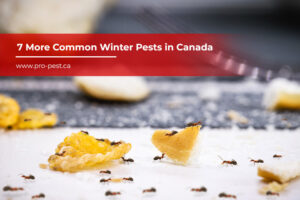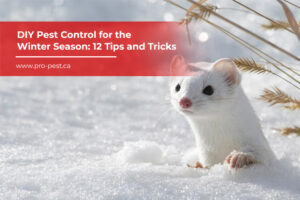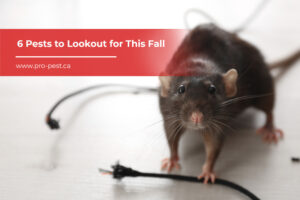With frosty weather settling in, many homeowners are confronted with unexpected and stubborn ant problems. Not only can ants infest your furniture or any unsealed food they find, but they could also cause massive damage to your property if left unaddressed. Being proactive at the first sign of trouble is the best way to avoid costly repair bills.
Enjoy your comfort of mind in a well-loved home this winter. Learn more about winter ant problems, and some practical tips on how to keep your house ant-free.

Ant activity in winter
Ant activity can be significantly affected by temperature changes in their environment since they are cold-blooded animals. A sudden change in temperature affects the majority of their functions, including movement, reproduction, and feeding.
As winter approaches, ants undergo a process of adaptation called ‘acclimation’ to build up a tolerance against freezing temperatures. This acclimation allows ants to survive in temperatures as cold as –30°C (or even lower). As temperatures fall, ants lessen their activity and bury themselves deep in the ground, emerging only to look for food and water. This means ants, while less active, do not entirely go dormant in the colder months.

Common species of invading ants
Ants are everywhere. The only places they do not thrive are Antarctica and a few inhospitable islands (like Greenland, Iceland, and some rocky islands in Hawaii and Polynesia). There are 12,000 known ant species in the world, but these five are the most common invaders of Canadian homes.
- Pharaoh ants – These critters invade pantries and cupboards to feast on human food. Typically, pharaoh ants are golden or light brown in colour and only 2 mm in size. They are more comfortable in warmer environments and will seek shelter from the elements in winter. Pharaoh ants can overrun a building very quickly, partially due to their unusual practice of having multiple breeding queens in a colony.

- Pavement ants – An invasive species originally from Europe, pavement ants are commonly found in tiny gaps and cracks in sidewalks and driveways, under concrete paving, and inside or alongside walls. Most are dark brown or black, and between 2.5 to 4 mm in size. They will feast on most foods items in the kitchen (including fruit, grains, greasy foods, and even unattended pet food). A colony of pavement ants can be difficult to eliminate and may require the assistance of a pest control expert.
- Field ants – Field ants are the most successful species on earth and can be found almost anywhere on the planet. These black ants can grow between 2.5 to 6.25 mm in length. Field ants can quickly saturate a home once they discover it to be an abundant source of food and water.
- Carpenter ants – The most destructive among the ant types, carpenter ants have termite-like tendencies. They love to tear down and burrow into wooden structures to build their nest. Carpenter ants can be black or brown and can grow to as long as 1.3 centimetres in length. They are also a sweets-loving population so be sure to keep sugary foods tightly sealed and stored. Carpenter ants can cause structural damage to property. For signs of infestation, call an exterminator right away for an immediate solution.
- Citronella ants – With size ranging from 4 to 8 millimetres and a translucent golden brown colour, citronella ants are often confused with termites due to its appearance. These ants thrive in moist areas like soil or rotting logs. You can detect the presence of citronella ants by the lemon-like odour they emit when disturbed, and the traces of dirt or wood they leave behind when digging through these surfaces. A citronella ant infestation can be a hassle to deal with, but they won’t cause damage to structures–unlike carpenter ants.

Why are there ants in my house?
There are many reasons why you might find ants inside your home in the winter. They could be a lone scout, searching for food or water. However (as with many pests) if you see one ant, there are likely several more you do not see. Some of the more concerning possibilities are:
- Worker ants found a seam in a window or door frame, and are overwintering in your home. Foraging ants usually enter homes during the warmer months to forage for food and stay inside walls until the cold has let up.
- A colony has built its nest very close to your home’s foundation. The ants you see are looking for food and water.
- A queen discovered a way into the house (perhaps through a small foundation crack or a window or door seam) and has established a colony in your home.

Infestation, or just a brief visit?
Once you have seen signs of ant trails or other activity inside your home, it can be challenging to figure out if you have a few foraging worker ants visiting or a full-blown infestation. Here are some clues to determine how severe your ant problem might be:
- A few isolated ants – If you’ve spotted an isolated few ants in only one or two areas of the house, these are likely worker ants seeking food and water. You will want to prevent them from returning or, even worse, being followed by a queen looking to establish a colony. The only way to do this is to kill them.
- A congregation of ants consistently in one area – This is a possible sign of infestation. Have a professional exterminator assess the situation swiftly and recommend an appropriate treatment.
- Winged ants in general – In most cases, winged adult ants in your home are a potential warning sign that an established ant colony is somewhere in or near the house or foundations. Call a professional exterminator immediately.

DIY ways to ward off ants
An infestation can be a frustrating problem leading to significant property damage. However, with care and attention, proactive strategies can make your home unappealing to these tiny invaders.
Here are some tips to prevent unwelcome insect visitors from crashing your place:
- Pest-proof your house in fall– The standard autumn pest-proofing techniques are as effective against ants as they are versus other unwanted guests, like mice, raccoons, rats, and cockroaches.
- Make your food inaccessible to them – Transfer dry food from the original cardboard or other packaging into sealable containers, and keep fruit and other perishables safely in the fridge. Remember, some ants will eat dry pet food, so make sure that their food is likewise sealed away.
- Clean the trail– Consistently clean your tables, countertops, and floors of any traces of crumbs, grime, and spills. Use cleaning chemicals if needed to distract ants. Spraying the ant trail with a mix of three parts soap and one part water will also remove the scent, preventing others from following the original invaders’ path.
- Block the trail– If you spot one ant in a corner, try to follow it to its source colony. Block the scent trail with a chalky substance (actual chalk, baking powder, or baby powder). This may interfere with their ability to follow the path into your house.

Do-It-Yourself ant control strategies can be effective. However, a severe infestation is challenging, and often requires a trained professional to assess the situation and find the right solution for your problem. Pro-Pest Animal Removal and Pest Removal Services uses the right tools and equipment to provide long-term and effective pest removal that is safe for people, pets, and the environment.
Call us at (416) 487-4179 or contact us online for safe and quick pest control in Toronto. Let us help keep your home pest-free not just in winter but all year round.



















